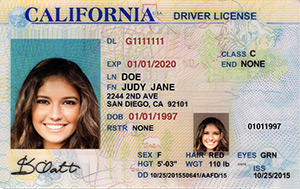Free DMV Written Test Practice for California | Updated for 2024 | CA

Verified by Steven Litvintchouk, M.S., Chief Educational Researcher, Member of ACES. See our detailed commitment to accuracy and quality in our practice tests.
4.32 out of 5 • 5962 votes
6 min to complete
Available in EN, ES, RU
California residents 15 ½ or older may apply for their driver’s permit to begin learning how to drive. In order to get your learner’s permit, you’ll need to take the California DMV written test, which will have 46 questions and you’ll be required to answer 38 correctly to pass. To get a permit, you’ll pay a $33 fee and must take a standard vision test at your local DMV, in addition to the written knowledge test. Those under 17 ½ will also be required to provide proof they are enrolled or have completed a driver’s education program. The DMV written test will be based on the information provided in the 2024 California Driver Handbook and will be multiple-choice and offered on a touchscreen computer. The fee for your written exam is good for 12 months and covers the cost of taking the test up to three times if need be. Use this DMV practice test to make sure you pass the first time!
What to expect on the actual exam
correct answers to pass
minimum age to apply
Helpful links
More resources
Easy
- CA DMV Practice Test 1
- CA DMV Practice Test 2
- CA DMV Practice Test 3
- CA DMV Practice Test 4
- CA Senior Refresher Test
- CA DMV Practice Test 5
- CA DMV Practice Test 6
Hard
- CA T/F Road Sign Test
- CA Signs & Situations Test
- CA Road Signs Mini
Hardest
- CA Fines & Limits Test
- CA Distracted Driving Test
- CA Drinking & Driving Test
Simulator
- CA DMV Exam Simulator
- Exam Simulator for Seniors
Are you in another state?
- Alabama: Test 1 / Test 2
- Alaska: Test 1 / Test 2
- Arizona: Test 1 / Test 2
- Arkansas: Test 1 / Test 2
- California: Test 1 / Test 2
- Colorado: Test 1 / Test 2
- Connecticut: Test 1 / Test 2
- Delaware: Test 1 / Test 2
- District of Columbia: Test 1 / Test 2
- Florida: Test 1 / Test 2
- Georgia: Test 1 / Test 2
- Hawaii: Test 1 / Test 2
- Idaho: Test 1 / Test 2
- Illinois: Test 1 / Test 2
- Indiana: Test 1 / Test 2
- Iowa: Test 1 / Test 2
- Kansas: Test 1 / Test 2
- Kentucky: Test 1 / Test 2
- Louisiana: Test 1 / Test 2
- Maine: Test 1 / Test 2
- Maryland: Test 1 / Test 2
- Massachusetts: Test 1 / Test 2
- Michigan: Test 1 / Test 2
- Minnesota: Test 1 / Test 2
- Mississippi: Test 1 / Test 2
- Missouri: Test 1 / Test 2
- Montana: Test 1 / Test 2
- Nebraska: Test 1 / Test 2
- Nevada: Test 1 / Test 2
- New Hampshire: Test 1 / Test 2
- New Jersey: Test 1 / Test 2
- New Mexico: Test 1 / Test 2
- New York: Test 1 / Test 2
- North Carolina: Test 1 / Test 2
- North Dakota: Test 1 / Test 2
- Ohio: Test 1 / Test 2
- Oklahoma: Test 1 / Test 2
- Oregon: Test 1 / Test 2
- Pennsylvania: Test 1 / Test 2
- Rhode Island: Test 1 / Test 2
- South Carolina: Test 1 / Test 2
- South Dakota: Test 1 / Test 2
- Tennessee: Test 1 / Test 2
- Texas: Test 1 / Test 2
- Utah: Test 1 / Test 2
- Vermont: Test 1 / Test 2
- Virginia: Test 1 / Test 2
- Washington: Test 1 / Test 2
- West Virginia: Test 1 / Test 2
- Wisconsin: Test 1 / Test 2
- Wyoming: Test 1 / Test 2
Your go-to, trusted source
Experience the Driving-Tests difference
Since our foundation in 2010, Driving-Tests.org has led the way in online driver's education, with over a decade of experience. Our dedicated experts, bringing together more than 50 years of collective expertise, have established us as the largest non-governmental organization in the U.S. solely focused on driver education. We go beyond the official manuals, offering unique interactive experiences and support like audio guides and an AI Assistant, to cater to different learning styles and needs.
Helping hundreds of thousands to ace their tests, our resources have earned a 4.7-star rating from over 14,500 reviews. Our goal is to make your path to becoming a confident driver as straightforward and effective as possible.
Close Created with Sketch.
Our commitment to accuracy and quality in our practice tests
Explore our rigorous, multi-tiered verification process that ensures each question mirrors the official manual for unparalleled accuracy.

Written by Andrei Zakhareuski Updated over a week ago
At Driving-Tests.org, we understand the importance of reliable and accurate practice tests to help you prepare for your DMV exam. That's why we've developed a meticulous process to create and continually update our practice questions, ensuring they reflect the most current driving laws and regulations.
Here's an inside look at how we maintain the highest quality in our practice tests.
Content Creation and Verification Process
- Alignment with Official Manuals:
Every question we develop is based on the most recent version of each state's official driving manual. Our team regularly monitors each state DMV's website for the latest updates to ensure our practice tests are always aligned with the most current information.
- Community Feedback Integration:
We leverage feedback from our vast community of users to understand which topics are most frequently tested. This helps us focus on the areas that are most relevant and beneficial for your preparation.
- Expert Content Creation:
Our in-house editor, Steven, who has extensive experience in driver education, crafts each question with precision. He conducts a thorough review of each question against the official manuals to ensure accuracy.
- Rigorous Review Process:
Once Steven has finalized a set of questions, our team conducts a joint review session. This second level of scrutiny involves content accuracy, proofreading, and fact-checking to eliminate any errors.
- User Feedback Mechanism:
After a question goes live on our site, we keep the lines of communication open. Each question features a feedback button, inviting users to report any issues or errors. This continuous feedback loop allows us to address and rectify any concerns promptly.
- Responsive Updates:
In line with our commitment to accuracy, we quickly update our practice questions to reflect any changes in the DMV manuals. Additionally, we update the free electronic copy of the state's driver's license manuals on our site, typically within a few days after the DMV publishes them.
Our thorough quality control process ensures that you have access to practice tests that are as accurate and up-to-date as possible. We believe in the power of well-prepared drivers and are dedicated to providing you with the best study tools to help you succeed on your DMV exam.
List of questions (classic view)
- When you approach a roundabout, you must enter to the _______ of the central island.
- What does this sign mean?
- When you turn off a high-speed, two-lane roadway, _______ if you have traffic following you.
- Your vehicle breaks down on a freeway. You are not able to move the vehicle off the road completely as the road shoulder is too narrow. What is the best thing to do?
- Blind pedestrians may carry _________canes or use guide dogs.
- When you park and leave your vehicle on a highway or street, you should NOT
- Which of these signs indicates a hospital ahead?
- All regulatory devices on the road tell you
- It is unsafe for you to pass when
- _________ are the most likely places for car and motorcycle collisions to occur.
- What does this sign indicate?
- If you are approaching a stop sign, you must
- What is the first rule of a safe and legal turn?
- A yield sign indicates that a driver must slow down and be prepared to _________ if a vehicle or pedestrian with the right-of-way is approaching from another direction.
- Before backing up your vehicle, you should look to the front, sides, and rear, and continue to look _________ while backing.
- In California, the speed limit for a blind intersection is
- You must use your high-beam headlights in all of the following situations, except
- Before reaching the crest of a hill or entering a curve, you must _________, and watch for oncoming vehicles.
- If a tire suddenly goes flat while you're driving, you should
- High-Occupancy Vehicle (HOV) lanes are reserved for
- A center lane between lanes of traffic traveling in opposite directions may be designated for
- If you plan to turn beyond an intersection, you must
- When parking on a public road, you must park parallel to and within ____ inches of the curb or edge of the roadway.
- What should you do if another driver tailgates your vehicle?
- What does this sign mean?
- When should you switch on your high-beam headlights?
- When turning left from a multi-lane one-way road onto another one-way road, start your turn from
- Which of the following statements about passing other vehicles is true?
- Which of the following statements about using headlights is FALSE?
- Following too closely behind another vehicle is called
- You are driving on the freeway and notice another driver using a handheld cell phone. What is the best thing to do?
- When you turn left from a one-way street onto another one-way street, you should turn into
- Large electronic flashing arrow panels may be used in work zones day and night to
- At an intersection, you should yield to another vehicle
- The wide white line painted across a traffic lane before an intersection is known as a
- What does this sign mean?
- What should you do if you are overtaking a bicycle and an oncoming vehicle is approaching at the same time?
- If a car approaches you with its high-beam headlights on, you must __________ to keep yourself from being temporarily blinded.
- Lanes of traffic going in opposite directions are divided by
- On a highway with three or more lanes going in one direction, vehicles passing others or turning left should use



